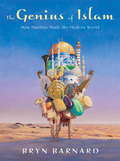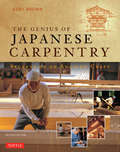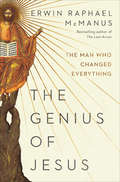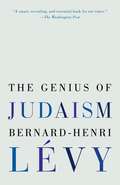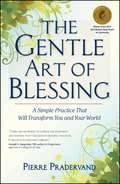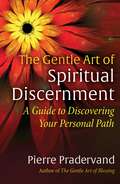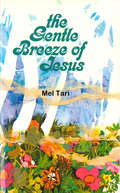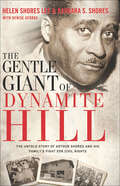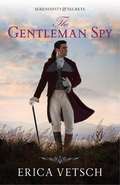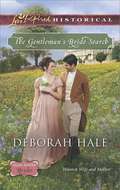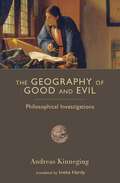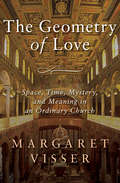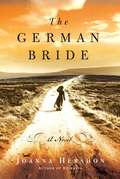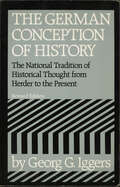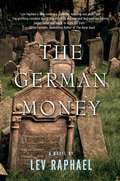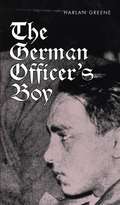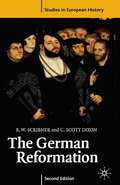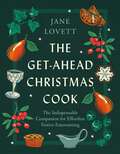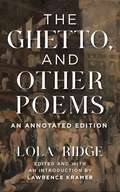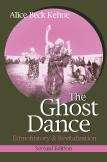- Table View
- List View
The Genius of Genesis
by Dennis G. ShulmanA profound and eloquent reading of the first chapter of the Bible.
The Genius of Islam: How Muslims Made the Modern World
by Bryn BarnardThe Middle Ages were a period of tremendous cultural and scientific advancement in the Islamic Empire--ideas and inventions that shaped our world. <P><P>Did you know that: <li>The numbers you use every day (Arabic numerals!) are a Muslim invention? <li>The marching band you hear at football games has its roots in the Middle East? <li> You are drinking orange juice at breakfast today thanks to Islamic farming innovations? <li>The modern city's skyline was made possible by Islamic architecture? <P><P>The Muslim world has often been a bridge between East and West, but many of Islam's crucial innovations are hidden within the folds of history. <P><P>In this important book, Bryn Barnard uses short, engaging text and gorgeous full-color artwork to bring Islam's contributions gloriously to life. Chockful of information and pictures, and eminently browsable, The Genius of Islam is the definitive guide to a fascinating topic.
The Genius of Japanese Carpentry
by Azby BrownThis new edition of this Azby Brown architecural classic contains a new preface by Brown, fully revised chapters, along 25% new photography and in color for the first time.An extraordinary and ambitious work of architectural reconstruction is underway in twenty-first century Nara. The Genius of Japanese Carpentry is the story of the twelve-hundred-year-old Yakushiji monastery and the dedicated modern-day craftsmen who are working to restore what has been lost to the depredations of time, fire, and warfare.In the eighth century, anonymous carpenters first erected the intricately-designed timber temples and pagodas that compose the Yakushiji Buddhist monastery. Then as today, these buildings were considered marvels of architectural elegance and traditional Japanese craftsmanship. Although the full restoration will not be complete until 2030, one of the main temples, the Picture Hall, has been completely reconstructed, employing the original methods, architectural style, and largely the same woodworking technology as its predecessors. Azby Brown chronicles the Picture Hall's painstaking restoration through photographs, extensive interviews with the carpenters and woodworkers, and original drawings based on the plans of Japanese master carpenter Tsunekazu Nishioka. An inspiring testament to the craftsmen, their dedication to excellence, and their philosophy of work as personal fulfillment, The Genius of Japanese Carpentry offers detailed documentation of this singular project and a moving reminder of the humanity that bridges past and present.
The Genius of Japanese Carpentry
by Azby BrownThis new edition of this Azby Brown architecural classic contains a new preface by Brown, fully revised chapters, along 25% new photography and in color for the first time.An extraordinary and ambitious work of architectural reconstruction is underway in twenty-first century Nara. The Genius of Japanese Carpentry is the story of the twelve-hundred-year-old Yakushiji monastery and the dedicated modern-day craftsmen who are working to restore what has been lost to the depredations of time, fire, and warfare.In the eighth century, anonymous carpenters first erected the intricately-designed timber temples and pagodas that compose the Yakushiji Buddhist monastery. Then as today, these buildings were considered marvels of architectural elegance and traditional Japanese craftsmanship. Although the full restoration will not be complete until 2030, one of the main temples, the Picture Hall, has been completely reconstructed, employing the original methods, architectural style, and largely the same woodworking technology as its predecessors. Azby Brown chronicles the Picture Hall's painstaking restoration through photographs, extensive interviews with the carpenters and woodworkers, and original drawings based on the plans of Japanese master carpenter Tsunekazu Nishioka. An inspiring testament to the craftsmen, their dedication to excellence, and their philosophy of work as personal fulfillment, The Genius of Japanese Carpentry offers detailed documentation of this singular project and a moving reminder of the humanity that bridges past and present.
The Genius of Jesus: The Man Who Changed Everything
by Erwin Raphael McManusA groundbreaking manifesto decoding the phenomenon of genius through the life of Jesus of Nazareth, revealing the untapped potential within every human being—from the bestselling author of The Artisan Soul, The Last Arrow, and The Way of the Warrior.&“IF ALL GENIUS IS TOUCHED BY MADNESS, THEN IT IS ALSO TOUCHED BY THE DIVINE.&” In every realm of our existence—art, science, technology, mathematics—we are captivated by stories of genius. Geniuses violate the status quo, destabilize conventional ways of thinking, and ultimately disrupt history by making us see the world differently. Genius is that rare expression of human capacity that seems to touch the divine.Jesus of Nazareth is undeniably one of the most influential figures ever to have walked the face of the earth. Yet his life as a work of genius has yet to be excavated and explored. In The Genius of Jesus, Erwin Raphael McManus examines the person of Jesus not simply through the lens of his divinity, but as a man who radically changed the possibility of what it means to be human.Drawing on the phenomenon of genius and the phenomenon of Jesus, McManus leads us to see this momentous figure in a new and life-altering way. Genius always leaves clues, and The Genius of Jesus follows those clues so that you can discover your own personal genius.McManus dives into the nuances of Jesus&’s words and actions, showing how they can not only inspire us but revolutionize how we think about power, empathy, meaning, beauty, and truth. This work is for anyone who seeks to transform their life from the mundane to the transcendent—for anyone who longs to awaken the genius within.The Genius of Jesus is a thought-provoking exploration of the most controversial and influential figure who ever lived, and a guide for you to discover how his genius can live in you.
The Genius of Judaism
by Bernard-Henri Lévy Steven B. KennedyFrom world-renowned public intellectual Bernard-Henri Lévy comes an incisive and provocative look at the heart of Judaism. For more than four decades, Bernard-Henri Lévy has been a singular figure on the world stage—one of the great moral voices of our time. Now Europe's foremost philosopher and activist confronts his spiritual roots and the religion that has always inspired and shaped him—but that he has never fully reckoned with. The Genius of Judaism is a breathtaking new vision and understanding of what it means to be a Jew, a vision quite different from the one we’re used to. It is rooted in the Talmudic traditions of argument and conflict, rather than biblical commandments, borne out in struggle and study, not in blind observance. At the very heart of the matter is an obligation to the other, to the dispossessed, and to the forgotten, an obligation that, as Lévy vividly recounts, he has sought to embody over decades of championing “lost causes,” from Bosnia to Africa’s forgotten wars, from Libya to the Kurdish Peshmerga’s desperate fight against the Islamic State, a battle raging as we speak. Lévy offers a fresh, surprising critique of a new and stealthy form of anti-Semitism on the rise as well as a provocative defense of Israel from the left. He reveals the overlooked Jewish roots of Western democratic ideals and confronts the current Islamist threat while intellectually dismantling it. Jews are not a “chosen people,” Lévy explains, but a “treasure” whose spirit must continue to inform moral thinking and courage today. Lévy’s most passionate book, and in many ways his most personal, The Genius of Judaism is a great, profound, and hypnotic intellectual reckoning—indeed a call to arms—by one of the keenest and most insightful writers in the world. Praise for Bernard-Henri Lévy’s Left In Dark Times “Moving and inspiring . . . Bernard-Henri Lévy, perhaps the most prominent intellectual in France today, [speaks] truth to power.”—The Boston Globe “Continually asking himself as well as others to confront the hard questions, [Lévy] produces a text that [is] highly absorbing.”—The New York Times Book Review “[Lévy’s] discussion of contemporary anti-Semitism is sophisticated, detailed and convincing.”—Los Angeles Times American Vertigo “An entertaining trip, as much in the tradition of Jack Kerouac as Tocqueville.”—The New York Times “Perceptive, pugnacious, passionate [and] exquisitely written.”—The New York Observer “It’s difficult to remember when a writer of any nationality so clearly and thoughtfully delineated both the good and bad in America. [Grade: A].”—Entertainment WeeklyFrom the Hardcover edition.
The Genre of Acts and Collected Biography
by Sean A. AdamsIt is widely accepted by New Testament scholars that the Gospel of Luke and the Acts of the Apostles probably originated as two parts of one work by a single author. In spite of this, the books have been assigned to very different genres: Luke is traditionally viewed as a biography of Jesus, and Acts as a history of the early church. Comparing in detail the structure and content of Acts with the formal features of history, novel, epic and biography, Sean Adams challenges this division. Applying both ancient and modern genre theory, he argues that the best genre parallel for the Acts of the Apostles is in fact collected biography. Offering a nuanced and sophisticated understanding of genre theory, along with an insightful argument regarding the composition and purpose of Acts, this book will be of interest to those studying the New Testament, Acts, genre theory and ancient literature.
The Gentle Art of Blessing: A Simple Practice That Will Transform You and Your World
by Pierre PradervandHow can a blessing change the world? According to Pierre Pradervand, making the conscious choice to bless every person or being around you can truly make a world of difference in yourself and in others around you. In The Gentle Art of Blessing, Pradervand shows that the practice of blessing has the power to create more than just a renewed perspective. It unleashes tangible benefits throughout your entire life -- through your daily interactions, your life-long relationships, and in the way your approach your place in the world. Pradervand describes blessing as genuinely wishing the best for another person through seeing their individual worth and honoring them for it. By looking at several different perspectives -- providing spiritual inspiration from Hinduism, Taoism, the Koran, the Bible, and other important spiritual sources -- The Gentle Art of Blessing explores the potential in shifting one's attitude from confrontation and negativity to acceptance and enthusiasm. A powerfully simple way of perceiving and shaping our surroundings, blessings can reflect the unconditional love and acceptance that is necessary for world -- and inner -- peace.
The Gentle Art of Spiritual Discernment: A Guide to Discovering Your Personal Path
by Pierre PradervandSupport for those embarking on an authentic spiritual search• Focuses in depth on helping you answer three fundamental questions: &“Who am I deep down?&”, &“What am I really looking for in my spiritual quest?&”, and &“What is the deep motivation of my search?&”• Shows how integrity, perseverance, generosity, and discernment are essential components of any lasting spiritual path• Reveals the author&’s own spiritual difficulties and how he reoriented his spiritual quest in a straightforward, less dogmatic wayThroughout his decades as a social activist and self-transformation teacher, as well as through his spiritual work with death row inmates, Pierre Pradervand saw more and more people moving away from organized religion. He also realized that many were still seeking a spiritual dimension in their lives. Yet with so many options available, especially so many &“spiritual fast food&” options, selecting the right spiritual path can be difficult.In this guide, Pierre offers support for those embarking on an authentic spiritual search. He focuses in depth on helping you answer three fundamental questions: Who am I deep down? What am I really looking for in my spiritual quest? What is the deep motivation of my search? He shows how integrity, generosity, and discernment are essential components of any lasting spiritual path. The author shares his journey to rediscover his spiritual power after losing it all. He explains how he reoriented his spiritual quest in a straightforward, less dogmatic way—which led him to discover the gentle art of blessing and the simple path to becoming an embodiment of divine love.Showing how to cultivate your inner voice and intuition to become your own empowered spiritual authority, this guide reveals how to see more clearly, open your spiritual horizons, and move toward your own unique spiritual path.
The Gentle Breeze of Jesus
by Mel TariIn this book, Mel Tari adds to the documentation he began in Like a Mighty Wind . On his native island in Indonesia, he says Moslems and animists are still coming to accept Jesus Christ and many other miracles and spiritual awakenings are continuing to happen.
The Gentle Giant of Dynamite Hill: The Untold Story of Arthur Shores and His Family's Fight for Civil Rights
by Denise George Helen Shores Lee Barbara S. ShoresThese are the firsthand accounts of sisters Helen and Barbara Shores growing up with their father, Arthur Shores, a prominent Civil Rights attorney, during the 60s in the Jim Crow south Birmingham district—a frequent target of the Ku Klux Klan. Between 1948 and 1963, some 50 unsolved Klan bombings happened in Smithfield where the Shores family lived, earning their neighborhood the nickname “Dynamite Hill.”Due to his work, Shores’ daughter, Barbara, barely survived a kidnapping attempt. Twice, in 1963, Klan members bombed their home, sending Theodora to the hospital with a brain concussion and killing Tasso, the family’s cocker spaniel. The family narrowly escaped a third bombing attempt on their home in the spring of 1965. The Gentle Giant of Dynamite Hill is an incredible story of a family’s unfair suffering, but also of the Shores’ overcoming. This family’s sacrificial commitment, courage, determination, and triumph inspire us today through this story and the selfless service, work, and lives of Helen Shores Lee and Barbara Sylvia Shores.
The Gentle Rebel (House of Winslow, #4)
by Gilbert MorrisThe Gentle Rebel brings the dynamic saga of the Winslow family into the American Revolution. Starting with the first Pilgrim settlement at Plymouth, The House of Winslow novels have vividly described the forces that shaped early American history and its people. Book 3, The Indentured Heart, brought the story to pre-Revolution days. Nathan Winslow, the son of Adam and Molly, was at first opposed to the idea of revolution against the British Crown, but eventually he becomes an American patriot. His love for the beautiful Abigail Howland, a proud and spoiled Tory, lies in direct conflict with his mission to help free his land. From the hotbed of patriotic activity in Boston to the green fields of Lexington, from Breed's Hill and Bunker Hill to the deadly overland winter trip toward Fort Ticonderoga- Winslow carries the banner of his family heritage and faith. Faith and courage-confirmed or denied?
The Gentleman Spy (Serendipity & Secrets #2)
by Erica VetschHe only wanted a duchess for a day--but she’s determined to make it a marriage for lifeWhen his father and older brother suddenly pass away, the new Duke of Haverly is saddled with a title he never expected to bear. To thwart the plans of his scheming family, the duke impulsively marries a wallflower. After all, she’s meek and mild; it should be easy to sequester her in the country and get on with his life--as a secret agent for the Crown.But his bride has other ideas. She’s determined to take her place not only as his duchess but as his wife. As a duchess, she can use her position to help the lowest of society--the women forced into prostitution because they have no skills or hope. Her endeavors are not met favorably in society, nor by her husband who wishes she’d remain in the background as he ordered.Can the duke succeed in relegating her to the sidelines of his life? When his secrets are threatened with exposure, will his new wife be an asset or a liability?
The Gentleman's Bride Search
by Deborah HaleMatchmaking with a Mission If Jasper Chase won't trouble himself to find a new governess, Evangeline Fairfax must find her employer a wife. That way, his children will be well cared for once she leaves to start a charity school. Jasper reluctantly agrees to a matchmaking house party with one condition-that Evangeline give him lessons in courtship. Devoted to improving conditions at his mill, Jasper unwittingly ignored matters at home. Only now, as Evangeline teaches him how to win a wife, does he realize what it means to be a true father and husband. And if this independent young woman would just say yes, her plan could have the perfect ending.... Glass Slipper Brides: From governess to Cinderella bride
The Geography of Good and Evil: Philosophical Investigations
by Andreas KinnegingDo good and evil exist? Absolutely. In this bracing book, the eminent Dutch philosopher Andreas Kinneging turns fashionable thinking on its head, revealing how good and evil are objective, universal, and unchanging—and how they must be rediscovered in our age. In mapping the geography of good and evil, Kinneging reclaims, and reintroduces us to, the great tradition of ancient and Christian thought. Traditional wisdom enables us to address the eternal questions of good and evil that confront us in both public and private life. Though it is common to accept uncritically the blessings of modernity and its intellectual sources, the Enlightenment and Romanticism, Kinneging shows that traditional thinking is richer and more realistic. Indeed, we see how, in more than a few respects, the Enlightenment and Romanticism brought not progress but deterioration. Kinneging skillfully reformulates and defends the insights of traditional thinking for today's readers, demonstrating how an objective morality is to be understood and how we can know what morality demands of us. At a time when the traditional virtues have practically disappeared from our language (that is, all but one—"tolerance"), he lays out the foundations of virtue and vice. Ultimately, Kinneging reveals the lasting significance of these seemingly archaic notions—to our own lives, to our families, to our culture, and to civilization. This profound, award-winning work establishes Andreas Kinneging as one of our wisest moral philosophers.
The Geometry of Love: Space, Time, Mystery, and Meaning in an Ordinary Church
by Margaret VisserThis enthralling study of the church of St. Agnes Outside the Walls brings to vivid life the stories, rituals, and architectural meaning contained within this seventeen-hundred-year-old building In The Geometry of Love, acclaimed author Margaret Visser, the preeminent "anthropologist of everyday life," takes on the living history of the ancient church of St. Agnes. Examining every facet of the building, from windows to catacombs, Visser takes readers on a mesmerizing tour of the old church, covering its social, political, religious, and architectural history. In so doing, she illuminates not only the church's evolution but also its religious legacy in our modern lives. Written as an antidote to the usual dry and traditional studies of European churches, The Geometry of Love is infused with Visser's unmatched warmth and wit, celebrating the remarkable ways that one building can reveal so much about our history and ourselves.
The German Bride: A Novel
by Joanna HershonBerlin, 1865. Eva Frank, the daughter of a benevolent Jewish banker, and her sister, Henriette, are having their portrait painted-which leads to a secret affair between young Eva and the mercurial artist. This indiscretion has far-reaching consequences, more devastating than Eva or her family could have imagined. Distraught and desperate to escape her painful situation, Eva hastily marries Abraham Shein, an ambitious merchant who has returned home to Germany for the first time in a decade since establishing himself in the American West. The eighteen-year-old bride leaves Berlin and its ghosts for an unfamiliar life halfway across the world, traversing the icy waters of the Atlantic and the rugged, sweeping terrain of the Santa Fe Trail. Though Eva's existence in the rough and burgeoning community of Sante Fe, New Mexico, is a far cry from her life as a daughter of privilege, she soon begins to settle into the mystifying town, determined to create a home. But this new setting cannot keep at bay the overwhelming memories of her former life, nor can it protect her from an increasing threat to her own safety that will force Eva to make a fateful decision. Joanna Hershon's novel is a gripping and gritty portrayal of urban European immigrants struggling with New World frontier life in the mid-nineteenth century. Vivid and emotionally compelling, The German Bride is also a beautiful narrative on how far one must travel to make peace with the past.BONUS: This edition includes an excerpt from Joanna Hershon's A Dual Inheritance.
The German Conception of History: The National Tradition of Historical Thought from Herder to the Present
by Georg G. IggersThe first comprehensive critical examination in any language of the German national tradition of historiography This is the first comprehensive critical examination in any language of the German national tradition of historiography. It analyzes the basic theoretical assumptions of the German historians of the nineteenth and twentieth centuries and relates these assumptions to political thought and action. The German national tradition of historiography had its beginnings in the reaction against the Enlightenment and the French Revolution of 1789. This historiography rejected the rationalistic theory of natural law as universally valid and held that all human values must be understood within the context of the historical flux. But it maintained at the same time the Lutheran doctrine that existing political institutions had a rational basis in the will of God, though only a few of these historians were unqualified conservatives. Most argued for liberal institutions within the authoritarian state, but considered that constitutional liberties had to be subordinated to foreign policy—a subordination that was to have tragic results. Mr. Iggers first defines Historismus or historicism and analyzes its origins. Then he traces the transformation of German historical thought from Herder's cosmopolitan culture-oriented nationalism to exclusive state-centered nationalism of the War of Liberation and of national unification. He considers the development of historicism in the writings of such thinkers as von Humboldt, Ranke, Dilthey, Max Weber, Troeltsch, and Meinecke; and he discusses the radicalization and ultimate disintegration of the historicist position, showing how its inadequacies contributed to the political débâcle of the Weimar Republic and the rise of National Socialism. No one who wants to fully understand the political development of national Germany can neglect this study.
The German Money
by Lev Raphael"Lev Raphael is a daring writer--one who will not be -restrained by genre, but who tells his story with all the tools at his command. The German Money combines all of Raphael's estimable talents, delivering an emotional thriller about a totally believable contemporary family coming to terms with fifty years of silence."--Edmund WhiteBest known for Dancing on Tisha B'Av, the groundbreaking story collection exploring the lives of children of Holocaust survivors, Lev Raphael is also the author of five popular mysteries. Now he combines his talents in a story of emotional suspense.Paul has spent his life running--from New York, the city of his birth; from his beautiful beshert; from contact with his own siblings; but mostly from his mother, a Holocaust survivor of inexplicable coldness. Upon her mysterious death, the children face shocking questions. What caused her to die? Why did she divide their inheritance so that Paul, the least favorite son, was singled out to receive the most, the dreaded "German money,"a bequest of a million dollars accrued from German reparations to survivors . . . a gift as cynical as it is generous."Lev Raphael's new novel is a powerful, haunting and erotic tale. The stunning narrative builds to a shocking -denouement and kept me turning pages faster and faster to learn the truth."--Linda FairsteinLev Raphael is the author of thirteen books and known internationally as an insightful chronicler of the lives of the children of Holocaust survivors. Winner of the Lambda Literary Award, among many prizes, his short works have appeared in two dozen anthologies, including American Jewish Fiction: A Century of Stories. He is a book critic for National Public Radio and mysteries columnist for the Detroit Free Press.
The German Officer's Boy
by Harlan GreeneWhat really happened that afternoon in November 1938, when the young Polish Jew walked into the German embassy in Paris and shots rang out? The immediate consequence was concrete: Nazi Germany retaliated with the "Night of Broken Glass," recognized as the beginning of the Holocaust. Lost and overlooked in the aftermath is the arresting story of Herschel Grynszpan, the confused teenager whose murder of Ernst vom Rath was used to justify Kristallnacht. In this historical novel, award-winning writer Harlan Greene may be the first author to take the Polish Jew at his word. Historians have tried to explain away Herschel Grynszpan's claim that he was involved in a love affair with vom Rath; Greene, instead, traces the lives of the underprivileged and persecuted Herschel Grynszpan and the wealthy German diplomat Ernst vom Rath as they move inevitably towards their ill-fated affair. In spare, vivid, and compelling prose, Greene imagines their world, their relationship, and their last horrific encounter, as they tried to wrest love and meaning from a world that would itself soon disappear in a whirlwind of disaster and madness.
The German Reformation: Second Edition
by C. Scott Dixon R. W. ScribnerOver the past twenty years, new approaches to the history of the Reformation of the Church have radically altered our understanding of that event within its broadest social and cultural context. In this classic study R. W. Scribner provided a synthesis of the main research, with a special emphasis on the German Reformation, and presented his own interpretation of the period. Paying particular attention to the social history of the broader religious movements of the German Reformation, Scribner examined those elements of popular culture and belief which are now seen to have played a central role in shaping the development and outcome of the movements for reform in the sixteenth century. Scribner concluded that 'the Reformation', as it came to be known, was only one of a wide range of responses to the problem of religious reform and revival, and suggested that the movement as a whole was less successful than previously claimed. In the second edition of this invaluable text, C. Scott Dixon's new Introduction, supplementary chapter and bibliography continue Scribner's original lines of inquiry, and provide additional commentary on developments within German Reformation scholarship over the sixteen years since its first publication.
The Get-Ahead Christmas Cook: The indispensable companion for effortless festive entertaining
by Jane Lovett'There is no-one whose recipes I trust more' India Knight'The ultimate stress-busting guide for the festive period' Appetite Magazine Get ahead of the festive frenzy with The Get-Ahead Christmas Cook!Christmas is coming, but how does it always manage to take us by surprise? The Get-Ahead Christmas Cook is the ultimate stress-busting guide for the festive period, with failsafe recipes that can be prepared and often made ahead, along with hints, tips and menus for the big day and beyond. Along with the classics, this book contains many original and delicious new recipes. Everything is covered, from canapés for Christmas drinks parties to hassle-free ideas for all kinds of seasonal entertaining, as well as foolproof recipes for the big day itself, including vegetarian and vegan alternatives. There are also lots of creative tricks for using up leftovers, plus - if you have any room left - indulgent baking and sweet treats.Whether you are an absolute novice or a seasoned pro, The Get-Ahead Christmas Cook will soon become your essential Christmas companion.
The Ghetto, and Other Poems: An Annotated Edition
by Lola RidgeAt last recovered in this enriching annotated edition, this important but neglected work of American modernism offers a unique poetic encounter with the Jewish communities in New York’s Lower East Side.Long forgotten on account of her gender and left-wing politics, Lola Ridge is finally being rediscovered and read alongside such celebrated contemporaries as Hart Crane, William Carlos Williams, and Marianne Moore—all of whom knew her and admired her work. In her time Ridge was considered one of America’s leading poets, but after her death in 1941 she and her work effectively disappeared for the next seventy-five years. Her book The Ghetto and Other Poems, is a key work of American modernism, yet it has long, and unjustly, been neglected. When it was first published in 1918—in an abbreviated version in The New Republic, then in full by B. W. Huebsch five months later—The Ghetto and Other Poems was a literary sensation. The poet Alfred Kreymbourg, in a Poetry Magazine review, praised “The Ghetto” for its “sheer passion, deadly accuracy of versatile images, beauty, richness, and incisiveness of epithet, unfolding of adventures, portraiture of emotion and thought, pageantry of pushcarts—the whole lifting, falling, stumbling, mounting to a broad, symphonic rhythm.” Louis Untermeyer, writing in The New York Evening Post, found “The Ghetto” “at once personal in its piercing sympathy and epical in its sweep. It is studded with images that are surprising and yet never strained or irrelevant; it glows with a color that is barbaric, exotic, and as local as Grand Street.”The long title poem is a detailed and sympathetic account of life in the Jewish Ghetto of New York’s Lower East Side, with particular emphasis on the struggles and resilience of women. The subsequent section, “Manhattan Lights,” delves further into city life and immigrant experience, illuminating life in the Bowery. Other poems stem from Ridge’s lifelong support of the American labor movement, and from her own experience as an immigrant. This critical edition seeks to recover the attention The Ghetto, and Other Poems, and in particular the title poem, lost after Ridge’s death. The poems in the volume are as aesthetically strong as they are historically revealing. Their language combines strength and directness with startling metaphors, and their form embraces both panoramic sweep and lyrical intensity. Expertly edited and annotated by Lawrence Kramer, this first modern edition to reproduce the full 1918 publication of The Ghetto and Other Stories offers all the background and context needed for a rich, informed reading of Lola Ridge’s masterpiece.
The Ghost Chronicles
by Maureen Wood Ron KolexJourney into a world of the unexplained and the unknown, a world where what you can't see captivates all your attention. A trance medium and a paranormal scientist team up in this spellbinding collection of 17 supernatural mysteries, a mere sampling of the spooky episodes in their vast ghost hunting case files.
The Ghost Dance: Ethnohistory and Revitalization (2nd Edition)
by Alice Beck KehoeIn this ethnohistorical case study of North American Indians, the Ghost Dance religion is the backbone for Alice Kehoe's exploration of significant aspects of American Indian life and her quest to learn why some theories become popular. In Part 1, she combines knowledge gained from her first and experiences living among and speaking with Indian elders with a careful analysis of historical accounts, providing a succinct yet insightful look at people, events, and institutions from the 1800s to the present. She clarifies unique and complex relationships among Indian peoples and dispels many of the false pretenses promoted by United States agencies over two centuries. In Part 2, Kehoe surveys some of the theories used to analyze the events described in Part 1, allowing readers to see how theories develop, to think critically about various perspectives, and to draw their own conclusions.

